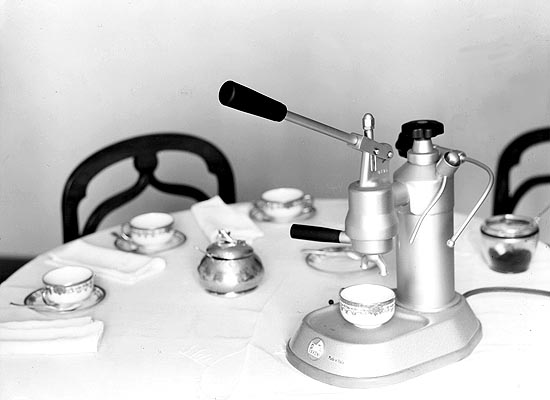La Pavoni Spa was founded
in Milan in 1905 thanks to Desiderio Pavoni in a little
workshop at Via Parini. His first invention was patented by Luigi
Bezzera, on 1st September 1902, and gave life to the first espresso
coffee machine for bar called "Ideale".
In the 1961, developing an idea by a
Milanese artisan, the first electrical machine for domestic use
was created. This machine could it to brew espresso coffee and hot
drinks, just like the way they were made in the coffee bar. That machine
was called "Europiccola".
In 1977, the "Europiccola" was coupled with the new
machine, the "Professional", whose boiler enabled to
obtain 16 coffees to be made consecutively. This model was equipped with
a manometer indicating the boiler pressure.
(extract from www.lapavoni.com)
The history of "Pavoni domestic" is identified with the history of the Europiccola, which inspires all models that will be produced over the decades, from the Professional, of which it is said that a specimen is exposed to the New York MoMA Museum, until the recent Stradivari, produced in 2005 to mark the centenary of the company..
The model Europiccola was born at least a couple of years before 1961, produced and marketed by a small company in Milan specialized in the production of electrical heating elements, called DP and sold under the brand name DP and Co-FER but only intuition and commercial strength of La Pavoni will make it a worldwide success remained unchanged for over 50 years
The machine was designed in a simple and rational, and in the simplicity there is its perfection and its immutability over time: each component was designed to last and integrate harmoniously with all others. The transformations that have occurred over time, while improving ease of use and safety, have lost much of the original spirit and affected the quality of the components.

Its main components are:
-
a boiler with a capacity of 0.8 liters
-
a heating element to double-power (600W + 200W) in a position to achieve and maintain a pressure of about 1 atmosphere
-
a group connected to the boiler by a pipe
-
a lever that operates the piston which allows the entry of the water into the group and the subsequent escape to the portafilter
-
a tap that allows you to deliver steam through a pipe
-
a base of metal, a switch at two-position and a sub-base of rubber
The first model (1961) was devoid of the sight level of the water and it was forced to check the water level every time you wanted to make the coffee.
This problem suggests to La Pavoni to make the first substantial change to the machine, with the addition on the boiler of two supports made of metal and one sight glass, connected to each other, so you can immediately check the minimum and maximum water temperature (1962).
Another minor inconvenience was due to water that drips from the holder filter after made the coffee, and falls on the base. To maintain the base to be dry it then use a small container or a rag. To resolve this problem La Pavoni has modified the base, to obtaining a basic tank to collect water that falls from the holder, topped by a grid of perforated aluminum that serves as a support plan (1964).
Having solved the first practical problems related to the use of the machine, begin problems related to maintenance performed by the Service Centers.
Regular maintenance consists essentially in replacing the seals of the
group , the duration of which is of some years.
In the machines of those years the group was not removable but screwed
directly onto the boiler, in addition, there was a brass sleeve bounded
with the shower and that could be unscrewed only with a special key.
These particularities make uncomfortable the replacement of seals,
especially after a few years of use of the machine. To facilitate the
maintenance La Pavoni initially changes the sleeve brass and separates
the shower (1970)
and completely eliminates the brass sleeve (1974), deemed no longer necessary. This reduces the diameter of the group so that the piston can slide inside the group. An other change it that the group is simply fixed to the boiler with two bolts. This system remained unchanged until today.
A final practical problem to be resolve was linked to the mode of ignition and shutdown of the machine, that happens simply inserting or disconnecting the power cord into the mains, because the switch has only two positions (minimum-maximum). Then is introduced the switch at three-position (0-I-II) with the possibility to turn off the machine without disconnecting the power cord (1974).
In justifying why in 1974 la pavoni focuses most of the substantive changes dell'Europiccola, we must remember that in the same year is launched on the market the Professional model, which has already all the changes made on Europiccola model, plus some safety equipment such as thermofuse and pressurestat, devices for which we have to wait several years before they are made available on the model Europiccola.
The following years saw the type of aesthetic interventions, such as the
introduction of the models in chrome or brass-copper (1978) and
interventions aimed at simplifying maintenance, such as heating element
not screwed on the boiler but fixed to the base with 3 bolts (1980).
And speaking of heating element, one of the most frequent problems that happens due to carelessness and is the nightmare of owners of europiccola is the breaking of the element due to lack of water in the boiler.
To reduce the risk of burning the element in case of accidental lack of
water is then added a thermofuse mounted on a cavity made on the element
(1987)..
But the heating element to double filament that still characterizes the machines, requires to the users a constant monitoring of the machine after power on, because, upon reaching the pressure of 1 atmosphere, it is necessary to manually move the switch from the position II position I.. And finally is it the time for the Europiccola model, to align the devices of security as the Professional model, with the adoption of resistance to a single filament, the pressurestat and thermofuse (1990).
.From this point on any change is made simultaneously on the two models, Europiccola and Professional.
The first step common to both models is to improve the preparation of
cappuccino, using an automatic system that aspires milk from the
container and returns it fitted into the cup. To allow easy removal of
the steam pipe and insert the cappuccino pipe, la pavoni modifies the
steam tap body in way to release the pipe with an automatic clutch
(1994).
We are at the end of 90's, are now almost 40 years from commercialization of the first Europiccola and all the changes have not altered the original draft, the modes of operation have not changed and aesthetically the machine is riched and modernized. Thousands are his admirers all over the Western world, are born several forums and amateur sites and the exchange of experiences between users show one of problems that assume a greater importance of others. In practice, many users complain that, having made some coffee, the temperature of the group becomes excessive, the water comes out at a temperature higher than normal and the quality of coffee is unsatisfactory.
These reports come directly from users or through the Service Centers,
to La Pavoni who initially modifies the calibration of the pressure in
an attempt to decrease the operating temperature of the boiler, with
reducing the pressure from 0,8-1,0 atm. to 0,5-0.8 (1996).
Subsequently la pavoni modifies the group by introducing inside a sleeve
in teflon in order to improve the thermal performance of the group. In
practice, you will return to the origins, to the model of 60's, with the
difference that the use of sleeve in Teflon instead of sleeve in brass
increases the diameter of the group of 2 mm and the resulting increasing
of filters and filter holder (2001).
The changes described above are the most significant and important, but many others were there the changes in 50 years from when the Europiccola enchanted its admirers, and this makes practically unique every machine output from its factories.
© 2008-2013 Francesco Ceccarelli All rights reserved.
Reproduction in any form
without permission
is prohibited
